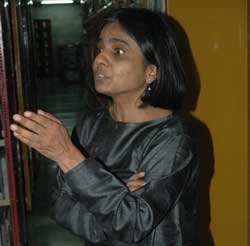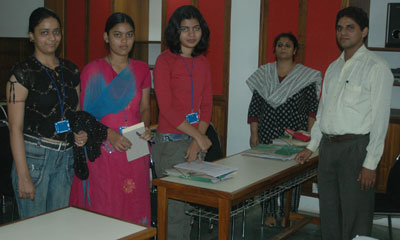SWEDISH SOUTH ASIAN STUDIES NETWORK
Visit to the Centre for Science and Environment (CSE), Delhi
Thursday 1 November 2007
Web page: http://www.cseindia.org/
 After much needed rest we went to our first appointment in the afternoon – a 45 minute drive due south from our Nordic Centre in India residence, to the Tughlaqabad Institutional Area, near Jamia Hamdard University and Jahanpanah City forest. Here we were to meet Sunita Narain (photo to the right), Director of the Centre for Science and Environment (CSE), a prestigious institute with several Swedish connections. Ms. Narain has previously been a member of the board of the Stockholm Environment Institute (SEI), and is a regular key speaker (as recently as 2007) at the Stockholm World Water Week, held in August every year.
After much needed rest we went to our first appointment in the afternoon – a 45 minute drive due south from our Nordic Centre in India residence, to the Tughlaqabad Institutional Area, near Jamia Hamdard University and Jahanpanah City forest. Here we were to meet Sunita Narain (photo to the right), Director of the Centre for Science and Environment (CSE), a prestigious institute with several Swedish connections. Ms. Narain has previously been a member of the board of the Stockholm Environment Institute (SEI), and is a regular key speaker (as recently as 2007) at the Stockholm World Water Week, held in August every year.
Two years ago CSE came into the limelight because of its research findings regarding residual amounts of pesticide in Coca Cola produced in India. It created a storm of debate in the country. Every issue of the Down to Earth magazine, published by CSE, is full of very competent articles focusing on environmental problems, not only inside India but also around the globe. For example, in the 31 October 2007 issue that we brought with us from Sweden (since SASNET has a standing subscription on to the magazine), a shocking article about the pharmaceutical companies in Andhra Pradesh reveals that high rates of antibiotics are found in the effluents discharged by industrial estates around Hyderabad. The article is based on work by a group of Swedish researchers, headed by Dr. Joakim Larsson, Associate Professor at the Department of
Physiology,
Institute of Neuroscience and Physiology, the Sahlgrenska Academy at Göteborg University.
Because of CSE’s high reputation, Sunita Narain is a much sought-after person. We arrived a bit late for our appointment, and therefore had to wait until after she had finished an interview with a major Japanese newspaper and a meeting with two parliamentarians from Germany.
Anil Agarwal Green Centre
 |
| Gita Kavarana and Aditya Batra presenting the work at the Green Centre. |
In the meantime, we were introduced to Mr. Aditya Batra and Ms. Gita Kavarana, who are responsible for the Anil Agarwal Green Centre within CSE. Since 2005, the Green Centre organises a variety of environmental four-day training programmes once or twice per month, many with international participants. The demand for these courses is much higher than can be met by CSE. They vary in content, depending on which unit within CSE organises a specific programme.
• Three units working on water issues, focusing on a) on groundwater harvesting, b) water management, and c) river pollution.
• One unit on industrial issues
• One unit on air pollution
• One unit on rural issues and environmental regeneration
Since 2005, the Green Centre has also been involved in a collaboration project with the Centre for Environment and Development (SUM) at the University of Oslo. Every year, Norwegian students from the Centre for Development and Environment (SUM) at Oslo University come to India – the next group is due in March 2008 – to attend a month-long programme designed by CSE, including a one week field trip outside of Delhi. This exchange project was made possible mainly through the friendship that had developed between Prof. Harold Wilhite at SUM, and Sunita Narain during a research project Wilhite conducted in 1987. So far the exchange program has been a success. External speakers in different fields are invited to lecture on such topics as water issues and forestry rights. The students are required to present a fieldwork report, and CSE, through its magazine and other publications (Mr. Batra is both a sociologist and a journalist), publishes these reports in different forms. Last year they were issues in a magazine, and this year as an impressive website presentation. More information about the exchange project and the 2007 batch of students.
 |
| Salahuddin Saiphy, Assistant Coordinator, Community Water Management and Rainwater Harvesting Unit, CSE, teaching students in one of the training programmes. |
In 2005 there were 15 students coming to CSE, and they were the first ones to have the honour of attending lectures at the Anil Agarwal Green College. In 2006 there were 21 students. CSE and SUM have the intention of expanding the exchange. This year we are 18, but there is a desire to increase the number of students to 30 and find a way to fund international students at SUM, taking SUM3000/4000, to also join in the exchange project.
Swedish collaboration wanted
CSE’s Green Centre is interested in establishing similar forms of collaboration with Swedish universities. Aditya Batra told us that he recently was in contact with one Swedish university about this option.
We were taken around the buildings and shown the water harvesting project and many other things CSE is involved in. When Sunita Narain eventually arrived, she enthusiastically showed us the impressive library, with its unique collection of books and magazines on environmental issues. She also told us about the documentation work they do every day, ploughing through 50 Indian daily newspapers in several regional languages, clipping and scanning all articles on the environment. This documentation will soon be available on the web through a new Internet portal from CSE. SASNET will, of course, link up to this important Internet resource as soon as it opens.
SASNET - Swedish South Asian Studies Network/Lund
University
Address: Scheelevägen 15 D, SE-223 70 Lund, Sweden
Phone: +46 46 222 73 40
Webmaster: Lars Eklund
Last updated
2010-02-02
